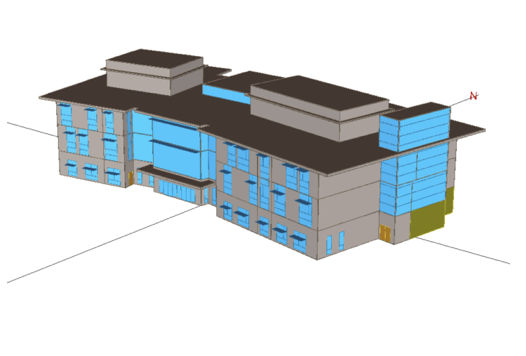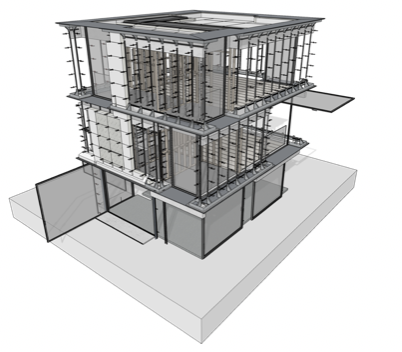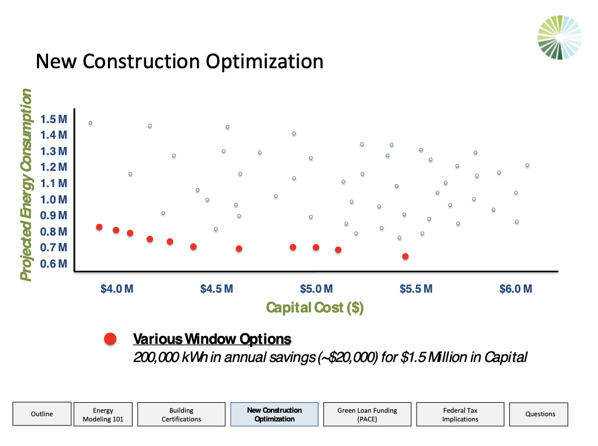Energy Modeling
Data-Driven Decisions = Decreased Operating Costs
Why
Simply put, the reason to have a computer simulation (energy model) of your facility created is so you can make decisions about the construction and design of your facility with as much realistic data as possible. An energy model will empower you to more deeply understand the long-term operating cost implications of decisions you make about your project.
First costs of a construction project are certainly important to consider, but if you plan to own/operate your facility or expansion, then shouldn’t the operating costs be fully understood when you are making design decisions? An energy model will enable you to separate the “sales pitches” from the “real opportunities” for savings that make business sense, in the short term and the long term.
For a fraction of your total project cost, an energy model will give you confidence, greater understanding and deliver you a more sustainable future, financially and environmentally.
How
Our team begins every energy modeling project with efforts to deeply understand the goals and needs of our clients. We perform a detailed review of your design goals and collect all necessary information, including building geometry, lighting, wall materials, etc. It is crucial to understand the building’s purpose, whether it is being built from the ground up, or being renovated to better suit your company’s needs. This knowledge is vital – especially for early design – to show how different variations of materials and equipment used will have an impact on your building’s energy footprint.
Once we have learned the crucial information about the building, our Building Energy Modeling Professionals (BEMP) and engineers are able to create a digital model of the facility. This computer simulation replicates and evaluates potential performance for everything within your building envelope – it encompasses all physical aspects of a building, including wall materials, windows, HVAC, and lighting to lead to better-informed decision making around the building’s design. We consider factors like weather patterns, occupancy rates, and human comfort when creating realistic and optimal designs.
The Foresight engineering team uses software to simulate a full year of weather conditions associated with your location to calculate realistic energy usage and efficiency. We also incorporate actual and projected utility cost information based on the utility providers for your facility. By changing different parameters within the program, we can help you realize what options available are best suited to your building, with both your budget and energy use in mind.
Benefits
• Stronger confidence in your building’s first costs, net costs, ROI, SROI, NOI, etc.
• Better understanding of how your facility uses energy
• Performance and budget expectations are met or exceeded
• Assists in achieving various “green” building certifications (LEED, Well, NetZero, EnergyStar, etc.)
• New Construction Optimization
• Green Loan Funding (PACE)
• Federal Tax benefits (179D)
We partnered with the Foresight Management’s engineering team to build an energy model for a major renovation project. The project was applying for C-PACE financing and required an energy model that accurately projected energy consumption and cost as compared to minimum baselines set forth by local jurisdictions. Foresight’s team was able to provide accurate and understandable results and turned them around within the tight timelines we were working under. Their expertise in the energy modeling space was vital to our team’s overall success.
Greenworks Lending
Frequently Asked Questions
When is the best time to do an energy model?
The sooner, the better! By using energy modeling at the beginning of your project, it is a much more powerful tool with helping your organization realize potential savings, both energy and budget-wise. Your team will be equipped with the knowledge and resources to explore more options that may have not been considered previously.
What type of projects are best suited for energy modeling?
Facility expansions, re-models and new construction
What types of buildings would benefit from an energy model?
Almost all facilities! Foresight has worked with industrial sites, grocery stores, recreational spaces, universities, commercial buildings, and many other types of spaces.
Is Foresight Management an Architectural Firm? Or offer design services?
No. We work alongside Architectural and Design Firms to bolster their efforts and give our clients a deep dive from an energy cost/use perspective.
Is Foresight Management a Construction Manager or General Contractor?
No. We work alongside CM and GC firms to empower them to make data driven decisions with regards to energy cost/use impact of the projects they work on.
How could the results of an energy model lower my initial construction costs?
An energy model can validate or disprove many assumptions made in the typical design process. For example, if the design calls for wall insulation of R20, an energy model will show you the energy use/cost outcomes of that level of insulation. It will also demonstrate what R10 or R30 insulation levels would produce. Seeing these variations based on real data will enable you to know exactly how much money the R20 insulation will save you over the R10.
If the energy reduction and cost savings is minimal, perhaps it would make more sense for your project to be constructed with R10, thus saving you initial construction costs. This example is applicable to every system in the facility that is impacted by energy usage.
How accurate are energy models?
Extremely, and yet, they are not perfect because some things are not perfectly predictable. We will learn about the intended use of the building during the design phase, but what happens if the use of the building changes in the future? We will assign the correct weather conditions to the facility based on geography, but what happens if our future weather patterns do not match historical patterns? We will build the model to match the schematic designs exactly, but what if the building is not constructed to the specs exactly?
Claiming 100% accuracy of the future state of the facility is impossible, so we call out all of our assumptions throughout the modeling process. That said, full building energy models are exponentially more accurate and empowering compared with not having one at all, or simply having a basic HVAC model.
How much does an energy model cost?
Depending on the complexity of the project and the number of design iterations, energy models can range from as little as $2,500 to as much as $50,000.
Will an energy model help me learn how to identify and capture utility rebate incentives?
Yes and no. An energy model on its own will not identify utility incentives, although it will tell you how much energy various technologies will save/consume. If performing an energy model for your project, our team can study the local utility incentive programs and add that layer of information to the energy model report. Foresight has dedicated utility incentive experts that will assist our energy modeling team in delivering this value to your project. Often times, the value of the utility rebate incentives is significantly higher than the cost to build the model. So if you hire us to do both the energy model and the incentive coordination for your project, we will likely drive significant financial returns on your engagement with us.
We partnered with Foresight to build an energy model for an affordable housing project in Chicago. The project is complying with multiple efficiency programs, so it was critical to accurately project consumption and costs so that funding would not be jeopardized. Foresight’s team provided us with the results we needed, in the timeframe that was required. They went above and beyond to answer our client’s needs and were a key component to the project’s success.
President, EcoAchievers







